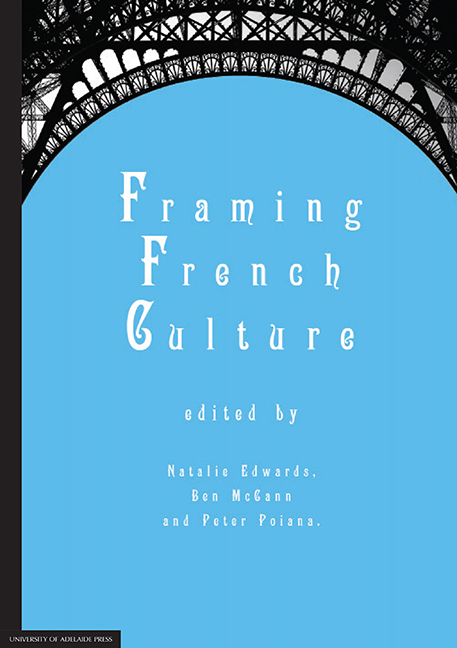Book contents
- Frontmatter
- Contents
- Introduction
- Part 1 Historical framings
- Part 2 Cultural icons and cinematic framings
- Part 3 Photographic framings
- 8 Annie Ernaux's phototextual archives: Ecrire la vie
- 9 The image of self-effacement: The revendication of the autonomous author in Marie NDiaye's Autoportrait en vert
- 10 Accumulating Algeria: Recurrent images in Pied-Noir visual works
- Part 4 Artistic framings
8 - Annie Ernaux's phototextual archives: Ecrire la vie
from Part 3 - Photographic framings
Published online by Cambridge University Press: 05 February 2016
- Frontmatter
- Contents
- Introduction
- Part 1 Historical framings
- Part 2 Cultural icons and cinematic framings
- Part 3 Photographic framings
- 8 Annie Ernaux's phototextual archives: Ecrire la vie
- 9 The image of self-effacement: The revendication of the autonomous author in Marie NDiaye's Autoportrait en vert
- 10 Accumulating Algeria: Recurrent images in Pied-Noir visual works
- Part 4 Artistic framings
Summary
Why would a writer publish a text that seemingly undoes the literary innovation of her life's work? Annie Ernaux has achieved fame by writing short, pithy narratives that recount isolated autobiographical moments. Rather than recounting events and extrapolating their meaning to her life within an autobiographical text, such as Michel de Montaigne falling off a horse, Jean-Jacques Rousseau stealing a ribbon, or André Gide travelling to North Africa, Ernaux chooses a specific incident — a love relationship, an abortion, a scene of domestic violence, for example — and describes this in sparse, unlyrical prose with no discussion of its consequences upon her developing selfhood. These moments instead hang as though suspended in mid-air, forming disjointed snapshots of episodes which invite identification or disidentification from the reader. Likewise, rather than linking these autobiographical moments into a coherent, cogent and complete self that hints at the Lejeunian notion of autobiography as the history of development of personality, Ernaux's texts defy linkage; some narrators are identified by different names or not at all, she rejects a chronological approach to life writing, and she plays with temporality.
So why now publish an anthology of previously published texts in one volume, placing her texts chronologically within her life and seemingly joining the dots between her autobiographical moments? Why invite a reading of ‘her’ as one, unitary identity that is a process and a product of the moments that she had previously rendered in such an isolated manner? Ecrire la vie, published in 2011, presents ten of Ernaux's texts in one volume, organised, according to the author's preface, by her. She claims that ‘c'est la succession des âges qui organise les textes’ (p. 8), since they are not presented according to their order of publication but instead to the time of her life that they depict. Furthermore, she does not comment upon or justify the choice of the ten. Since Ernaux is the author of nearly twenty texts, part of her corpus is absent, which gives rise to questions over concealment, repression and, as Derrida has written with respect to archives, how a narrative of identity may be based on what is discarded rather than on what is included.4 Some of her most famous, prize-winning texts, such as Une Femme and La Place, form part of the anthology.
- Type
- Chapter
- Information
- Framing French Culture , pp. 177 - 192Publisher: The University of Adelaide PressPrint publication year: 2015



